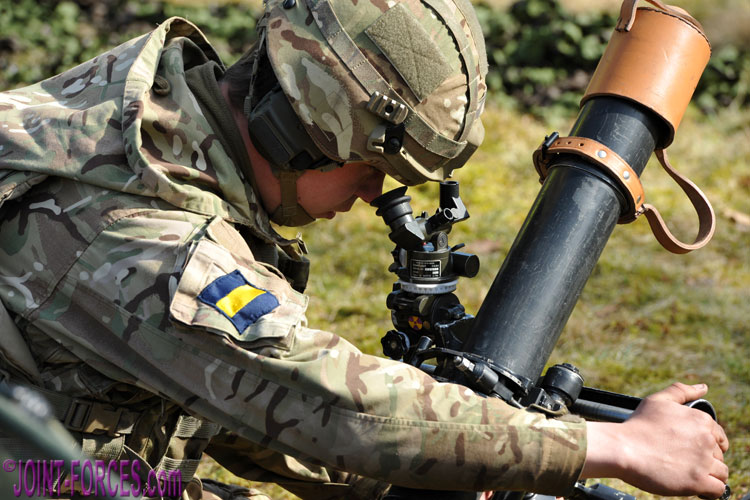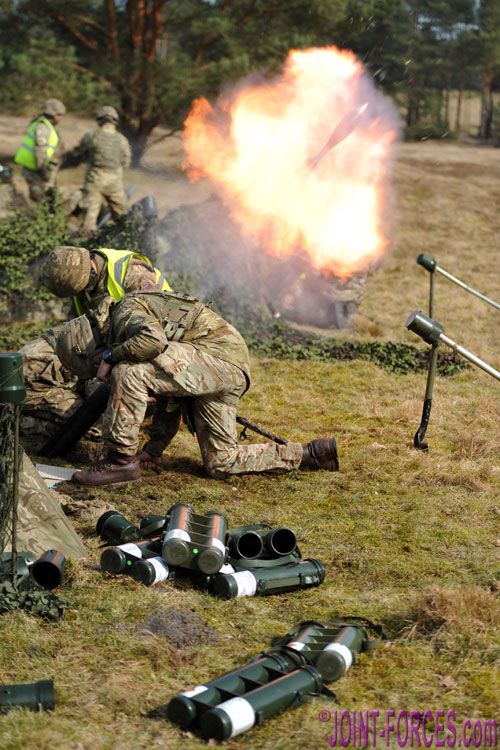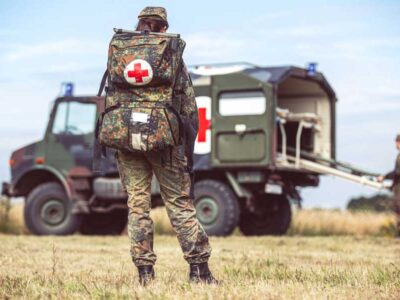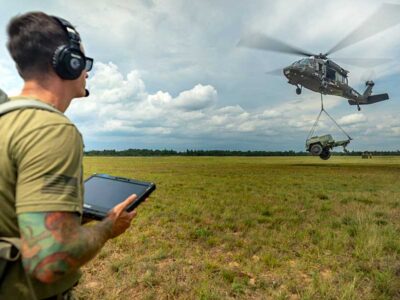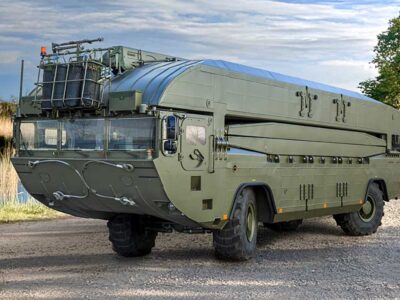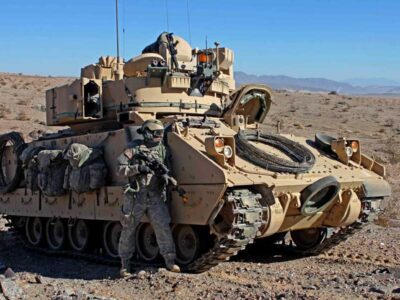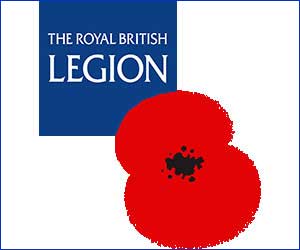With their Mortar Platoon infantry battalions of the British Army can field their own integral indirect fire asset, regardless whether the battalion serves in the Armoured Infantry, Protected Mobility or Light Infantry role, writes Carl Schulze.
Forming part of the Fire Support Company of the battalion, the Mortar Platoon can be deployed as a whole or in sections in order to support the companies of a battlegroup with highly accurate indirect fire during operations. In March 2018 the Mortar Platoon of the 1st Battalion, The Princess of Wales’s Royal Regiment (1 PWRR) conducted its Mortar Cadre, aimed at training new soldiers as mortar men.
We visited the package to provide you with an overview of the training, the platoon structure and the 81mm L16A2 mortar itself. Lasting four weeks and conducted at Sennelager Training Area, the Mortar Cadre of the Mortar Platoon of the 1 PWRR had the aim of qualifying mortar men to be competent in all types of operation. During the cadre the participants learned all about the tactical and conceptual elements of being in the Mortar Platoon.
The cadre contained lessons about mortar basics, the 81mm L16A2 mortar, ammunition in service, tactics and so on, as well as challenging practical training, including: exercises in how to operate the mortar in offensive, defensive, rural and urban environments; physically challenging marches during which the roughly 50kg mortar had to be carried; and a week-long live fire package. During the live fire the 16 new mortar men taking part in the Mortar Cadre fired well over 400 81mm L41A4 High Explosive and 80 81mm L54A1 Illumination Rounds.

After a fire mission is completed a mortar man of 1 PWRR cleans the barrel of an 81mm L16A2 Mortar [© Carl Schulze]
A highlight of the training package was Exercise HEAVY CARRY, during which the ability of the new mortar men to carry heavy weights over long distances was tested. As part of this exercise the soldiers carried an average load of 55kg each over a distance of eight kilometres before executing a fire mission; all this had to be performed in under 90 minutes.
Another mini exercise saw the troops providing indirect fire support to B Company, 1 PWRR while it was conducting platoon level live fire attacks. During this the new mortar men had to engage targets at a distance out to 2,000m and as close as 500m to their own comrades assaulting the enemy position.
Despite the fact that the 1st Battalion, The Princess of Wales’s Royal Regiment currently serves in the armoured infantry role most of the training was conducted using light role infantry tactics, as 1 PWRR will move from Germany to Cyprus and convert into a Light Role Infantry Battalion in 2019.
Mortar Platoon Structure
The main mission of the Mortar Platoon is to support elements of a Battle Group formed by 1 PWRR during operations with highly accurate defensive and offensive indirect fire in order to neutralise enemy forces and deny them the use of the ground.

“Fire!” The No 2 drops an 81mm L41A4 High Explosive round into the barrel of an L16A2 Mortar [© Carl Schulze]
The Mortar Platoon of 1 PWRR numbers some 50 troops and consists of the Platoon Headquarters, the Mortar Fire Control Section and three Mortar Sections. The Platoon Headquarters provides the Joint Fires Cell (JFC) in the Battle Group Headquarter of a Battle Group formed by the battalion.
Among other tasks the JFC coordinates the employment of indirect fire assets and close air support assets supporting the Battle Group, including the integral Mortar Platoon as well as artillery assets and fixed and rotary wing aircraft assigned for support. The JFC also advises the commander of the Battle Group on the detailed use and coordination of mortars and other fire resources available in order to achieve maximum effect.

Ammunition fired by the L16A2 Mortar the L41A4 High Explosive and the 81mm L54A1 Illumination rounds [© Carl Schulze]
The three Mortar Sections are equally structured and each consists of a Command Post and three Mortar Detachments. The Mortar Detachments are each three strong and can field one 81mm L16A2. Of the mortar team, the No 1 commands it and aims the mortar, the No 2 fires the mortar by inserting the round into the barrel and the No 3 is responsible for preparing the ammunition, for example by setting the fuses of the mortar rounds and ensuring that the rounds feature the right charge.
81mm L16A2 Mortar

The 81mm L16A2 Mortar consists of Barrel, Bipod, Baseplate, C2 Sight and the Number One Bag containing all ancillaries [© Carl Schulze]
The L16A2 is in service with units of the British Army, the Royal Marines and the Royal Air Force Regiment. Designed by the Royal Armament Research and Development Establishment (RARDE) and manufactured by Royal Ordnance this 81mm mortar is also fielded by several foreign users, such as the armed forces of Australia, Canada, Malta, the Netherlands, Norway and New Zealand.
The weapon consists of Barrel weighing 13kg, Bipod weighing 12.9kg, Baseplate weighing 11.6kg, C2 Sight weighing 3.8kg and Number One Bag weighing 7kg; the latter contains all of the weapon ancillaries. The mortar can be employed mounted, installed in the rear of an FV432 Mk3 Bulldog tracked armoured personnel carrier or dismounted by using its baseplate.

Using a Fire Control Assembly a member of the Command Post calculates a fire command [© Carl Schulze]
The elevation and traverse mechanisms are sealed to allow long life and less maintenance. The base plate with its four deep webs provides good support for the mortar in the ground. It is forged in light alloy and has a diameter of 546mm. Accessories belonging to the mortar include, among other equipment, a cleaning brush, a muzzle cover, two aiming posts, a tool for removing jammed rounds and a spare parts box including a spare firing pin.

The fuse of the 81mm L41A4 High Explosive ammunition can be set for detonation on impact or delayed detonation [© Carl Schulze]
When the 81mm L16A2 Mortar is used to fire the 81mm L54A1 Illumination or the 81mm L58A1 Infra-Red Illumination rounds it has a range of 400m to 4,800m. These rounds feature an illumination radius of 400m, with the L54A1 having an illumination intensity of 1,000,000 candela and a burn time of 30 seconds. The L58A1 has a burn time of 90 seconds and offers troops the ability to see the battlespace clearly illuminated through night vision equipment. The 81mm L42A3 White Phosphorus Smoke round has a range of 100m to 5,675m and is employed to produce a dense white smokescreen for a period of 60 seconds.


